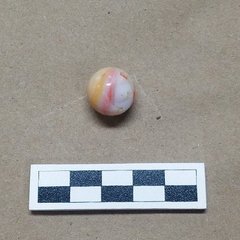This opaque glass marble was recovered during the excavations around the Long Barrack. The glass marble is opaque white with a yellow, orange, and red swirl. This particular marble was recovered from one of the trenches observed adjacent to the foundations within the Long Barrack.
The trenches appear to have been excavated to expose the foundation for repair work. The soils that were replaced contained artifacts that dated to all periods of occupation. The opaque swirl marble appears to be a common variety manufactured during the early 1900s.
This marble does not exhibit a pontil scar, although a section of the marble exterior was damaged. If there was a pontil scar, this would indicate the marble was handmade. Handmade glass marbles could appear in the area as early as the mid-1800s, and would have likely been introduced by the German settlers coming to San Antonio and the vicinity.
By the start of the WWI, handmade German marbles were almost impossible to purchase. Machine manufacturing of glass marbles began in 1850 as well, although the handmade versions were more sought after. It appears that the machine-made versions did not become more popular until after WWII.
It is difficult to assign an specific date to this marble due to the damage that may have removed evidence of a potential pontil scar.



